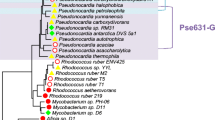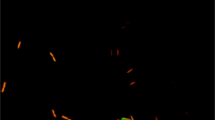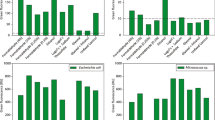Abstract
Sequential mRNA fluorescence in situ hybridization (mRNA FISH) and fluorescence-assisted cell sorting (SmRFF) was used for the identification of nitrite-reducing bacteria in mixed microbial communities. An oligonucleotide probe labeled with horseradish peroxidase (HRP) was used to target mRNA of nirS, the gene that encodes nitrite reductase, the enzyme responsible for the dissimilatory reduction of nitrite to nitric oxide. Clones for nirS expression were constructed and used to provide proof of concept for the SmRFF method. In addition, cells from pure cultures of Pseudomonas stutzeri and denitrifying activated sludge were hybridized with the HRP probe, and tyramide signal amplification was performed, conferring a strongly fluorescent signal to cells containing nirS mRNA. Flow cytometry-assisted cell sorting was used to detect and physically separate two subgroups from a mixed microbial community: non-fluorescent cells and an enrichment of fluorescent, nitrite-reducing cells. Denaturing gradient gel electrophoresis (DGGE) and subsequent sequencing of 16S ribosomal RNA (rRNA) genes were used to compare the fragments amplified from the two sorted subgroups. Sequences from bands isolated from DGGE profiles suggested that the dominant, active nitrite reducers were closely related to Acidovorax BSB421. Furthermore, following mRNA FISH detection of nitrite-reducing bacteria, 16S rRNA FISH was used to detect ammonia-oxidizing and nitrite-oxidizing bacteria on the same activated sludge sample. We believe that the molecular approach described can be useful as a tool to help address the longstanding challenge of linking function to identity in natural and engineered habitats.






Similar content being viewed by others
References
Radajewski S, Ineson P, Parekh NR, Murrell JC (2000) Stable-isotope probing as a tool in microbial ecology. Nature 403(6770):646–649
Manefield M, Whiteley AS, Griffiths RI, Bailey MJ (2002) RNA stable isotope probing, a novel means of linking microbial community function to phylogeny. Appl Environ Microbiol 68(11):5367–5373
Pelz O, Cifuentes LA, Hammer BT, Kelley CA, Coffin RB (1998) Tracing the assimilation of organic compounds using delta C-13 analysis of unique amino acids in the bacterial peptidoglycan cell wall. FEMS Microbiol Ecol 25(3):229–240
Roslev P, Iversen N (1999) Radioactive fingerprinting of microorganisms that oxidize atmospheric methane in different soils. Appl Environ Microbiol 65(9):4064–4070
Adamczyk J, Hesselsoe M, Iversen N, Horn M, Lehner A, Nielsen PH, Schloter M, Roslev P, Wagner M (2003) The isotope array, a new tool that employs substrate-mediated labeling of rRNA for determination of microbial community structure and function. Appl Environ Microbiol 69(11):6875–6887
Ouverney CC, Fuhrman JA (1999) Combined microautoradiography-16S rRNA probe technique for determination of radioisotope uptake by specific microbial cell types in situ. Appl Environ Microbiol 65(4):1746–1752
Zumft WG, Dreusch A, Lochelt S, Cuypers H, Friedrich B, Schneider B (1992) Derived amino-acid-sequences of the nosZ gene (respiratory N2O reductase) from Alcaligenes eutrophus, Pseudomonas aeruginosa and Pseudomonas stutzeri reveal potential copper-binding residues. Implications for the CuA site of N2O reductase and cytochrome-c oxidase. Eur J Biochem 208(1):31–40
Hallin S, Lindgren PE (1999) PCR detection of genes encoding nitrile reductase in denitrifying bacteria. Appl Environ Microbiol 65(4):1652–1657
Braker G, Zhou JZ, Wu LY, Devol AH, Tiedje JM (2000) Nitrite reductase genes (nirK and nirS) as functional markers to investigate diversity of denitrifying bacteria in Pacific northwest marine sediment communities. Appl Environ Microbiol 66(5):2096–2104
Liu XD, Tiquia SM, Holguin G, Wu LY, Nold SC, Devol AH, Luo K, Palumbo AV, Tiedje JM, Zhou JZ (2003) Molecular diversity of denitrifying genes in continental margin sediments within the oxygen-deficient zone off the Pacific coast of Mexico. Appl Environ Microbiol 69(6):3549–3560
Goregues CM, Michotey VD, Bonin PC (2005) Molecular, biochemical, and physiological approaches for understanding the ecology of denitrification. Microb Ecol 49(2):198–208
Hoshino T, Yilmaz LS, Noguera DR, Daims H, Wagner M (2008) Quantification of target molecules needed to by fluorescence in situ hybridization (FISH) and catalyzed reporter deposition-FISH. Appl Environ Microbiol 74(16):5068–5077
Chen H, Ponniah G, Salonen N, Blum P (2004) Culture-independent analysis of fecal enterobacteria in environmental samples by single-cell mRNA profiling. Appl Environ Microbiol 70(8):4432–4439
Pernthaler A, Amann R (2004) Simultaneous fluorescence in situ hybridization of mRNA and rRNA in environmental bacteria. Appl Environ Microbiol 70(9):5426–5433
Bakermans C, Madsen EL (2002) Detection in coal tar waste-contaminated groundwater of mRNA transcripts related to naphthalene dioxygenase by fluorescent in situ hybridization with tyramide signal amplification. J Microbiol Methods 50(1):75–84
Pilhofer M, Pavlekovic M, Lee NM, Ludwig W (2009) Fluorescence in situ hybridization for intracellular localization of nifH mRNA. Syst Appl Microbiol 32:186–192
Smolina I, Lee C, Frank-Kamenetskii M (2007) Detection of low-copy number genomic DNA sequences in individual bacterial cells by using peptide nucleic acid-assisted rolling-circle amplification and fluorescence in situ hybridization. Appl Environ Microbiol 73(7):2324–2328
Hoshino T, Schramm A (2010) Detection of denitrification genes by in situ rolling circle amplification-fluorescence in situ hybridization to link metabolic potential with identity inside bacterial cells. Environ Microbiol 12(9):2508–2517
Kawakami S, Kubota K, Imachi H, Yamaguchi T, Harada H, Ohashi A (2010) Detection of single copy genes by two pass tyramide signal amplification fluorescence in situ hybridization (two-pass TSA-FISH) with single oligonucleotide probes. Microbes and Environments 25(1):15–21
Moraru C, Lam P, Fuchs BM, Kuypers MMM, Amann R (2010) GeneFISH—an in situ technique for linking gene presence and cell identity in environmental microorganisms. Environ Microbiol 12(11):3057–3073
Biegala I, Not F, Vaulot D, Simon N (2003) Quantitative assessment of picoeukaryotes in the natural environment by using taxonspecific oligonucleotide probes in association with tyramide signal amplification-fluorescence in situ hybridization and flow cytometry. Appl Environ Microbiol 69:5519–5529
Lay C, Dore J, Rigottier-Gois L (2007) Separation of bacteria of the Clostridium leptum subgroup from the human colonic microbiota by fluorescence-activated cell sorting or groupspecific PCR using 16S rRNA gene oligonucleotides. FEMS Microbiol Ecol 60:513–520
Lenaerts J, Lappin-Scott HM, Porter J (2007) Improved fluorescent in situ hybridization method for detection of bacteria from activated sludge and river water by using DNA molecular beacons and flow cytometry. Appl Environ Microbiol 73:2020–2023
Miyauchi R, Oki K, Aoi Y, Tsuneda S (2007) Diversity of nitrite reductase genes in ‘Candidatus Accumulibacter phosphatis’-dominated cultures enriched by flow-cytometric sorting. Appl Environ Microbiol 73:5331–5337
Sekar R, Fuchs BM, Amann R, Pernthaler J (2004) Flow sorting of marine bacterioplankton after fluorescence in situ hybridization. Appl Environ Microbiol 70(10):6210–6219
Czechowska K, Johnson DR, van der Meer JR (2008) Use of flow cytometric methods for single-cell analysis in environmental microbiology. Curr Opin Microbiol 11:205–212
Manti A, Boi P, Amalfitano S, Puddu A, Papa S (2011) Experimental improvements in combining CARD-FISH and flow cytometry for bacterial cell quantification. J Microbiol Methods 87(3):309–315
Chen CH, Cho SH, Chiang H-I, Tsai F, Zhang K, Lo Y-H (2011) Specific sorting of single bacterial cells with microfabricated fluorescence-activated cell sorting and tyramide signal amplification fluorescence in situ hybridization. Anal Chem 83(19):7269–7275
Kalyuzhnaya M, Zabinsky R, Bowerman S, Baker DR, Lidstrom ME, Chistoserdova L (2006) Fluorescence in situ hybridization-flow cytometry-cell sorting-based method for separation and enrichment of type I and type II methanotroph populations. Appl Environ Microbiol 72:4293–4301
Jen CJ, Chou CH, Hsu PC, Yu SJ, Chen WE, Lay JJ, Huang CC, Wen FS (2007) Flow-FISH analysis and isolation of clostridial strains in an anaerobic semi-solid bio-hydrogen producing system by hydrogenase gene target. Appl Microbiol Biotechnol 74:1126–1134
Mota C, Head MA, Ridenoure JA, Cheng JJ, de los Reyes FL (2005) Effects of aeration cycles on nitrifying bacterial populations and nitrogen removal in intermittently aerated reactors. Appl Environ Microbiol 71(12):8565–8572
Throback IN, Enwall K, Jarvis A, Hallin S (2004) Reassessing PCR primers targeting nirS, nirK and nosZ genes for community surveys of denitrifying bacteria with DGGE. FEMS Microbiol Ecol 49(3):401–417
Mobarry BK, Wagner M, Urbain V, Rittmann BE, Stahl DA (1996) Phylogenetic probes for analyzing abundance and spatial organization of nitrifying bacteria. Appl Environ Microbiol 62(6):2156–2162
Mobarry BK, Wagner M, Urbain V, Rittmann BE, Stahl DA (1997) Phylogenetic probes for analyzing abundance and spatial organization of nitrifying bacteria (vol 62, pg 2157, 1996). Appl Environ Microbiol 63(2):815
Schramm A, de Beer D, Wagner M, Amann R (1998) Identification and activities in situ of Nitrosospira and Nitrospira spp. as dominant populations in a nitrifying fluidized bed reactor. Appl Environ Microbiol 64(9):3480–3485
de los Reyes FL, Ritter W, Raskin L (1997) Group-specific small-subunit rRNA hybridization probes to characterize filamentous foaming in activated sludge systems. Appl Environ Microbiol 63(3):1107–1117
Hung CH, Peccia J, Zilles JL, Noguera DR (2002) Physical enrichment of polyphosphate-accumulating organisms in activated sludge. Water Environment Research 74(4):354–361
Lin CZ, Stahl DA (1995) Taxon-specific probes for the cellulolytic genus Fibrobacter reveal abundant and novel equine-associated populations. Appl Environ Microbiol 61(4):1348–1351
Muyzer G, Dewaal EC, Uitterlinden AG (1993) Profiling of complex microbial-populations by denaturing gradient gel-electrophoresis analysis of polymerase chain reaction-amplified genes-coding for 16S ribosomal-RNA. Appl Environ Microbiol 59(3):695–700
Wallner G, Amann R, Beisker W (1993) Optimizing fluorescent insitu hybridization with ribosomal-RNA-targeted oligonucleotide probes for flow cytometric identification of microorganisms. Cytometry 14(2):136–143
de Araújo JC, Schneider RP (2008) DGGE with genomic DNA: suitable for detection of numerically important organisms but not for identification of the most abundant organisms. Water Res 42(20):5002–5010
Lai WA, Kämpfer P, Arun AP, Shen F-T, Huber B, Rekha PD, Young C-C (2006) Deinococcus ficus sp. nov., isolated from the rhizosphere of Ficus religiosa L. Int J Syst Evol Microbiol 56(4):787–791
Kämpfer P, Lodders N, Huber B, Falsen E, Busse H-J (2008) Deinococcus aquatilis sp. nov., isolated from water. Int J Syst Evol Microbiol 58:2803–2806
Im W-T, Jung H-M, Ten LN, Kim MK, Bora N, Goodfellow M, Lim S, Jung J, Lee S-T (2008) Deinococcus aquaticus sp. nov., isolated from fresh water, and Deinococcus caeni sp. nov., isolated from activated sludge. Int J Syst Evol Microbiol 58(10):2348–2353
Anesti V, McDonald IR, Ramaswamy M, Wade WG, Kelly DP, Wood AP (2005) Isolation and molecular detection of methylotrophic bacteria occurring in the human mouth. Environ Microbiol 7(8):1227–1238
Schulze R, Spring S, Amann R, Huber I, Ludwig W, Schleifer KH, Kampfer P (1999) Genotypic diversity of Acidovorax strains isolated from activated sludge and description of Acidovorax defluvii sp nov. Syst Appl Microbiol 22(2):205–214
Hwang C, Wu WM, Gentry TJ, Carley J, Carroll SL, Schadt C, Watson D, Jardine PM, Zhou J, Hickey RF, Criddle CS, Fields MW (2006) Changes in bacterial community structure correlate with initial operating conditions of a field-scale denitrifying fluidized bed reactor. Appl Microbiol Biotechnol 71(5):748–760
Mergaert J, Boley A, Cnockaert MC, Muller WR, Swings J (2001) Identity and potential functions of heterotrophic bacterial isolates from a continuous-upflow fixed-bed reactor for denitrification of drinking water with bacterial polyester as source of carbon and electron donor. Syst Appl Microbiol 24(2):303–310
Yan TF, Fields MW, Wu LY, Zu YG, Tiedje JM, Zhou JZ (2003) Molecular diversity and characterization of nitrite reductase gene fragments (nirK and nirS) from nitrate- and uranium-contaminated groundwater. Environ Microbiol 5(1):13–24
Khan ST, Horiba Y, Yamamoto M, Hiraishi A (2002) Members of the family Comamonadaceae as primary poly(3-hydroxybutyrate-co-3-hydroxyvalerate)-degrading denitrifiers in activated sludge as revealed by a polyphasic approach. Appl Environ Microbiol 68(7):3206–3214
Song BK, Palleroni NJ, Haggblom MM (2000) Isolation and characterization of diverse halobenzoate-degrading denitrifying bacteria from soils and sediments. Appl Environ Microbiol 66(8):3446–3453
Heylen K, Vanparys B, Wittebolle L, Verstraete W, Boon N, De Vos P (2006) Cultivation of denitrifying bacteria: optimization of isolation conditions and diversity study. Appl Environ Microbiol 72(4):2637–2643
Acknowledgments
We would like to thank Jose Trinidad Ascencio-Ibanez, Larissa Benavente, and Mariana Franco for their assistance with expression cloning; Janet Dow for assistance with flow cytometry; and Eva Johannes for assistance with CLSM. Funding was provided by the National Science Foundation (CBET 0853864).
Author information
Authors and Affiliations
Corresponding author
Rights and permissions
About this article
Cite this article
Mota, C.R., So, M.J. & de los Reyes, F.L. Identification of Nitrite-Reducing Bacteria Using Sequential mRNA Fluorescence In Situ Hybridization and Fluorescence-Assisted Cell Sorting. Microb Ecol 64, 256–267 (2012). https://doi.org/10.1007/s00248-012-0018-x
Received:
Accepted:
Published:
Issue Date:
DOI: https://doi.org/10.1007/s00248-012-0018-x




